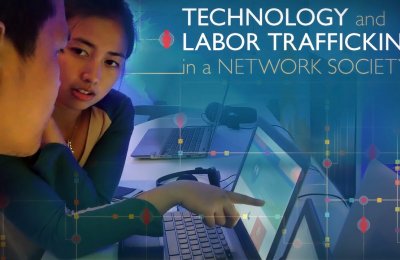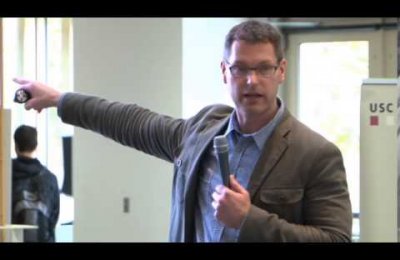By Krista Daly
Student Writer
The USC Annenberg Innovation Lab recently brought together television news professionals, technology executives, and USC faculty and students for a day-long workshop to explore one question: How can we reinvent TV news? (Watch the video.)
“There's this kind of disconnect between the way that news is produced and the way news is consumed,” said Gabriel Kahn, the USC Annenberg professor and AIL research fellow who organized the session of about 30 participants. “So the purpose of this was to try to see if we can find a way to harness these emerging technologies with TV news and revolutionize that process.”
The need to revamp the medium is urgent, participants said. Networks are not engaging everyone in the audience, said Sam Bailey, director of new media and technology for Frontline.
“The viewership of the broadcast experience is going to go down (in the next few years) and some sort of new hybrid form is more likely to take hold for younger audiences and more technologically advanced people,” Bailey said.
The workshop delved into two main themes: curation and personalization.
“People still want their news curated in some form,” Kahn said. “Nobody wanted just to be able to narrowcast their experience. They wanted to be able to make sure that they're not missing something, but at the same time, they don't like the fact that they have very little control over the experience when they sit down for TV.”
The sessions focused mainly on the use of second-screen technology – the use of Internet via smartphones, laptops, PCs or tablets – to supplement the TV viewing experience.
“A lot of technology being developed for second-screen is really good for drilling down on specific subjects,” said Erin Reilly, Managing and Creative Director for the lab. She added: “But the way it’s being displayed is still very much like your television. We sit back, relax and watch. You might be tapping, but you’re still consuming instead of being able to participate.”
One of the ideas that took shape during the workshop included creating technology that will allow the user to bookmark topics and build their own newscast throughout the day.
“People want to migrate seamlessly from device to device, from content source to content source and from platform to platform,” said Kahn. “Why can't I use, for example, my phone like a remote control all day long to possibly build a store of content that I want to then consume on my television.”
Kahn gave more details of that idea in a report on USC Annenberg’s OJR: Online Journalism Review:
"One scenario the group came up with is an app that would allow viewers to build their own broadcasts throughout the day. As soon as the sun comes up, the app pushes out a list of five video stories. Viewers can choose which ones to put in their playlist and which ones to discard. As the day moves forward, viewers are given more choices. Some come from pushed breaking news alerts; others come from the viewers’ own social network or favorite topics. The playlist is dynamic. Whenever the viewer has a free 20 minutes, he or she can watch the tailored broadcast on the device of choice – phone, tablet, computer or regular TV. The stories that play are the latest on a particular topic, so if you selected a story on the debt ceiling in the morning, then you’re greeted with the most up-to-date version when you decide to watch. The goal is to create a news package that is both customized and curated. Those two characteristics often appear to be at odds with each other. But it was clear from our day-long exercise that customers want both."
Another proposal floated is a news interface that allows a viewer to pause a broadcast and drill down on a topic. The audience would have instant access to the broadcaster’s digital archives from a list on the screen. At any time, the viewer could return to the broadcast.
Neil Joglekar, one of the attendees of the workshop, said the discussions were grounded in the kind of technology that already exists. Joglekar is one of the founders of Reel Surfer, a website that lets people cut short clips of videos from anywhere, string them together as one video, and share with friends.
“It doesn't matter where users are,” Joglekar said. “They're consuming it on mobile devices, at home, probably on the bus, in various places."
“Appointment viewing TV” of going to your house at 6 p.m. to watch the evening news is over, he added.
“We have to find a way to craft a product,” Kahn said, “that isn't going to be limited by the fact that I really need to sit down at 6 p.m. and watch something.”
Although viewership numbers show the national evening broadcast news is half the size it was in 1980, people are consuming news more than ever, Kahn said.
Erle Norton, the editorial director of Reuters Video at Thompson Reuters, said the big problem is that viewers are leaving traditional broadcast news. A portion of the audience probably doesn’t want broadcast television to change, he said.
“If you took the nightly news, the national channels NBC, CBS, ABC, and you made that into some Twitter orgy Facebook, that sort of thing,” Norton said. “I think everybody would leave.”
Instead, the focus of broadcast reinvention is turned to the people who are not currently watching TV news or are already leaving TV news.
“It's still serving a segment of the population, but that segment is shrinking and a new generation is emerging with completely different viewing habits and news consumption habits,” Kahn said.
The Annenberg Innovation Lab plans to collaborate with the participants of the workshop to create prototypes of the workshop’s ideas with the most potential.
“The lab is going to help bring together various partners – ABC news, Cisco, Microsoft and others that don’t necessarily work together and show them through our rapid prototyping process what could be possible,” said communication professor and AIL Director Jon Taplin. “Then we’ll leave it to them to make it commercialized, but we can show them what the possibilities are.”








